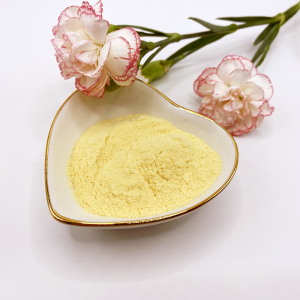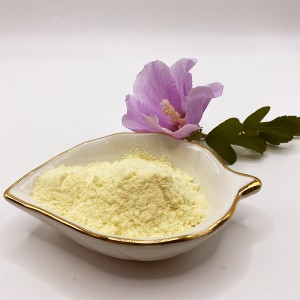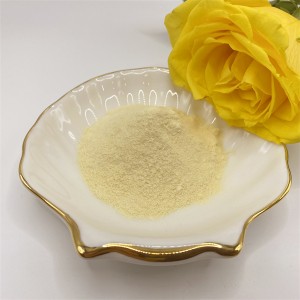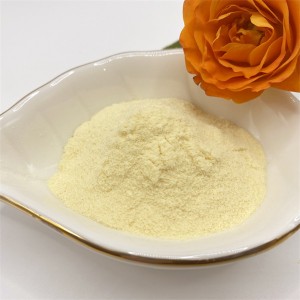Organic Amino Acid Fertilizer 80% Organic Nitrogen
General Information
|
Physical Properties |
Chemical Properties |
||
|
Color |
Light Yellow |
Total Amino acid Content |
≥80% |
|
Odor |
Special Aromatic |
Organic Nitrogen |
15~16% |
|
Water Solubility |
100% |
PH Value |
4~6 |
|
Moisture |
5% |
||
Benefits
1.Fast fertilizer effect
Amino acids in amino acid fertilizers can be directly absorbed by various organs of plants, passively absorbed or osmotically absorbed under photosynthesis, and obvious effects can be observed in a short period of time after use. At the same time, it can promote the early maturity of crops and shorten the growth cycle.
2.Improve crop quality
Abundant amino acid species can improve crop quality. If the protein content of grain is increased by 3%, the cotton has good velvet quality and long fiber; vegetables have good palatability, pure and delicious taste, and crude fiber reduces the flowering period of flowers, bright colors and rich aroma, melons and fruits, large color and good sugar content, and more edible parts. The storage is good, and the conversion benefit is remarkable.
3.Clean and pollution-free, improve the ecological environment
The amino acid fertilizer applied to the ground has no residue, which can improve the physical and chemical properties of the soil, improve the water and fertility retention and air permeability, and play the role of conservation, curing and soil improvement.
4.Enhanced metabolic function and improved resistance to stress
When amino acids are absorbed by crops, their physiological and biochemical functions can be strengthened. The stems of the crops are thick, the leaves are thickened, the leaf area is enlarged, the formation and accumulation of dry matter is accelerated, and the crops can mature earlier. Also due to their increased vitality, the resistance to cold and drought, the resistance to dry and hot wind, and the resistance to diseases and insect pests are improved, so as to achieve stable and high yields.
5.Well-developed root system, strong absorption
Amino acids have a special role in promoting the root development of crops. Many agricultural scientists call amino acids "root fertilizers". The main effect on the root system is to stimulate the division and growth of root meristem cells, so that the seedlings grow roots quickly. The number of secondary roots increases, the root volume increases, and the root system elongates, which ultimately leads to a greatly enhanced ability of crops to absorb water and nutrients.
6.Effects on the growth of vegetative bodies in the aerial part
On the basis of sufficient nutrient supply, the stimulating effect of amino acids can make the aerial part of the plant grow vigorously, which is manifested in plant height, stem diameter, number of leaves, dry matter accumulation, etc.
7. Effects on yield and composition factors
Amino acids have different effects on the yield and composition factors of different crops. They can increase the yield of grain crops, such as more ears, more grains, and 1,000-grain weight. In the early stage, they have good effects on tillering and reducing the rate of empty seedlings. Effects of Amino Acids on Crop Physiological Metabolism and Enzyme Activities.
After the amino acid enters the plant, it stimulates the plant, mainly in the increase of respiration intensity, the increase of photosynthesis, and the enhancement of the activities of various enzymes, so that the fruit is colored and matured in advance, and high yield and output value are obtained.
After the watermelon was administered with amino acids, the sugar content increased by 13-31.3% and the vitamin C content increased by 3-42.6.
Synergistic effect on chemical fertilizers
According to the field test. G-Teck organic amino acid 80 has special synergistic effect on chemical fertilizers:
1, Nitrogen fertilizer(N)
when mixed with amino acids, the absorption and utilization rate can be increased by 20-40% (carbon amine release). It takes more than 20 days for the nitrogen to be absorbed by the crops, and it can reach more than 60 days after mixing with amino acids).
The impact of amino acids on potential nitrogen in soil is multi-faceted. The stimulating effect of amino acids increases the prevalence of soil microorganisms, resulting in accelerated organic nitrogen mineralization. The volatilization loss also increases the content of soil available nitrogen.
2, Phosphate fertilizer (P)
The research on the effect of amino acids on phosphorus fertilizers has been carried out for many years. The results show that without adding amino acids, phosphorus moves vertically in the soil for a distance of 3 to 4 cm.after adding amino acids, it can be increased to 6 to 8 cm. Nearly double.
It is helpful for crop root absorption, amino acid has obvious effect on the decomposition of phosphate rock, and it has a protective effect on available phosphorus, reduces the fixation of available phosphorus in soil, promotes the absorption of phosphorus by crop roots, and improves the efficiency of phosphate fertilizer. Utilizing the absorption rate is extremely valuable.
3, Potassium fertilizer (K)
The acidic functional groups of amino acids can absorb and store potassium ions, prevent them from being lost with water in sandy soils and soils with strong leaching properties, and prevent the fixation of potassium in cohesive soils. Potassium silicate, potassium feldspar and other minerals have a dissolution effect, which can slowly decompose and increase the release, thereby increasing the content of soil available potassium.
Amino acids also contain a variety of nutrient elements, which have long-acting and quick-acting fertilizing effects on the growth of crops. Therefore, amino acids can be used as foliar fertilizers for foliar spraying, which can combine supplementary nutrition with Improve the double effect of photosynthesis at the same time and lay a solid foundation for the high yield and harvest of crops.
Frequently Asked Question
1. What’s the raw material of Organic amino acid 80 ?
Soybean meal;
2. What's the production technology ?
It's a kind of enzymatic hydrolysis process.
3. What’s the difference between Total Free amino acid 80 and Organic amino acid 80?
They are from same raw material, but production process are quite different. Since Total Free amino acid 80 is made by H2SO4, the molecular lines could be total cut into free amino acid form.
While, organic amino acid 80 is a kind of soft enzymatic hydrolysis process, molecular lines are not total cut, it contains peptide,small peptide,amino acid and free amino acid. It’s a kind of organic nitrogen.
Application
The product can reduce the energy used by plants for their production and translocation. The energy saved can be used by plants for other vital processes.
it is mainly used for different kinds of agricultural fertilizing fields: fruit, pastures, and horticultural crops, etc.
When blending with chemical fertilizers, utilization rate can be improved, in which the quantity used for fertilizers could be reduced.
Irrigation and foliar spray are recommended for the usage:
| Utilization rates can be improved by blending with chemical fertilizers and then reducing the amount used as fertilizer. | ||||||
| Fertilizing | Dilution Rates | |||||
| Foliar spray: | 1: 800-1000 | |||||
| Irrigation: | 1: 600-800 | |||||
Packaging and Storage
Packaging and storage Available in 1Kg, 5Kg, 10Kg, 20Kg bag,jumbo bag;
Storage: Dry, cool, direct sun light proof, moisture proof warehouse;
Shelf life: 36 months.













